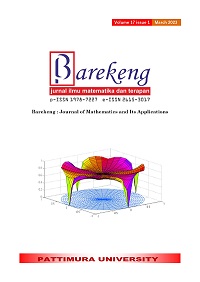MODIFIED WEIGHT MATRIX USING PRIM’S ALGORITHM IN MINIMUM SPANNING TREE (MST) APROACH FOR GSTAR(1;1) MODEL
Abstract
The Generalized Space-Time Autoregressive (GSTAR) model is able to utilize modeling of both space and time simultaneously. The existence of a weight matrix is one of the aspects that established this model. The matrix illustrates the spatial impact that occurs between locations. In this research, a modified weight matrix is presented using the Minimum Spanning Tree approach of graph theory. Prim's algorithm is utilized for calculation here. Not only does the modified weight matrix depend distance, but also highlights the correlation. It makes the modified weight matrix unique. Before starting Prim's algorithm, the correlation is first utilized as an input in forming the initial graph. Following that, find the graph with the least of MST weight. Afterwards, the graph is described utilizing weight matrix, which is applied to the normalization process. Following this, the GSTAR(1;1) modelling process is carried out, beginning with estimating the parameters and then forecasting. The case study is Covid-19 cases that occurred on Java Island between July 2020 (when early Covid-19 entered Indonesia) and the beginning of January 2021. The aim of the research is to model the Covid-19 cases using modified weights and to predict the following five times. The outcome is a GSTAR(1;1) model with modified weights can captures both temporal and spatial patterns. The accuracy of the model is achieved for both the training data and the testing data by the MAPE computations, which yielded of 11.40% and 21.57%, respectively. Predictions are also obtained for each province in the next five times.
Downloads
References
P. Pfiefer and S. Deutsch, “A Three-Stage Iterative Procedure for Space-Time Modeling,” Technometrics, vol. 22, no. 1, pp. 35–47, Feb. 1980.
Y. Yundari, U. S. Pasaribu, and U. Mukhaiyar, “Error Assumptions on Generalized STAR Model,” Journal of Mathematical and Fundamental Sciences, vol. 49, no. 2, p. 136, Oct. 2017, doi: 10.5614/j.math.fund.sci.2017.49.2.4.
U. Mukhaiyar, U. S. Pasaribu, W. S. Budhi, and K. Syuhada, “The stationarity of generalized STAR(2;λ1,λ2) process through the invers of autocovariance matrix,” 2014, pp. 484–487. doi: 10.1063/1.4868849.
P.-C. Lai, F.-M. So, and K.-W. Chan, Spatial Epidemiological Approaches in Disease Mapping and Analysis. CRC Press, 2008. doi: 10.1201/9781420045536.
N. Nurhayati, U. S. Pasaribu, and O. Neswan, “Application of Generalized Space-Time Autoregressive Model on GDP Data in West European Countries,” J Probab Stat, vol. 2012, pp. 1–16, 2012, doi: 10.1155/2012/867056.
U. Mukhaiyar and U. S. Pasaribu, “A New Procedure of Generalized STAR Modeling using IAcM Approach,” ITB Journal of Sciences, vol. 44, no. 2, pp. 179–192, 2012, doi: 10.5614/itbj.sci.2012.44.2.7.
U. Mukhaiyar, B. I. Bilad, and U. S. Pasaribu, “The Generalized STAR Modelling with Minimum Spanning Tree Approach of Weight Matrix for COVID-19 Case in Java Island,” J Phys Conf Ser, vol. 2084, no. 1, p. 012003, Nov. 2021, doi: 10.1088/1742-6596/2084/1/012003.
R. Munir, Matematika Diskrit, Third. Bandung, 2005.
T. T. Dimyati and A. Dimyati, Operations Research Model-Model Pengambilan Keputusan. Bandung: Sinar Baru Algensindo, 1999.
N. Subadra, “Directed Graph Algorithms for Tours - A Case Study,” Journal of Emerging Trends in Engineering and Applied Sciences (JETEAS), vol. 2, no. 4, pp. 615–618, 2011.
S. Borovkova, H. Lopuhaa, and B. Nurani, “Generalized STAR model with experimental weights,” in 17th International Workshop on Statistical Modelling, 2002, pp. 139–147.
Yundari, U. S. Pasaribu, U. Mukhaiyar, and M. N. Heriawan, “Spatial Weight Determination of GSTAR(1;1) Model by Using Kernel Function,” J Phys Conf Ser, vol. 1028, p. 012223, Jun. 2018, doi: 10.1088/1742-6596/1028/1/012223.
Suhartono and R. Atok, “Pemilihan Bobot Lokasi yang Optimal pada Model GSTAR.”
Badan Nasional Penanggulangan Bencana, “Update Percepatan Penanganan Covid-19 di Indonesia,” BNPB, Jan. 2021.
D. J. Cryer and K.-S. Chan, Time Series Analysis: With Application in R. USA: Springer Science and Bussiness Media, 2008.
Copyright (c) 2023 Nur'ainul Miftahul Huda, Fransiskus Fran, Yundari Yundari, Lisa Fikadila, Fauziah Safitri

This work is licensed under a Creative Commons Attribution-ShareAlike 4.0 International License.
Authors who publish with this Journal agree to the following terms:
- Author retain copyright and grant the journal right of first publication with the work simultaneously licensed under a creative commons attribution license that allow others to share the work within an acknowledgement of the work’s authorship and initial publication of this journal.
- Authors are able to enter into separate, additional contractual arrangement for the non-exclusive distribution of the journal’s published version of the work (e.g. acknowledgement of its initial publication in this journal).
- Authors are permitted and encouraged to post their work online (e.g. in institutional repositories or on their websites) prior to and during the submission process, as it can lead to productive exchanges, as well as earlier and greater citation of published works.






1.gif)



